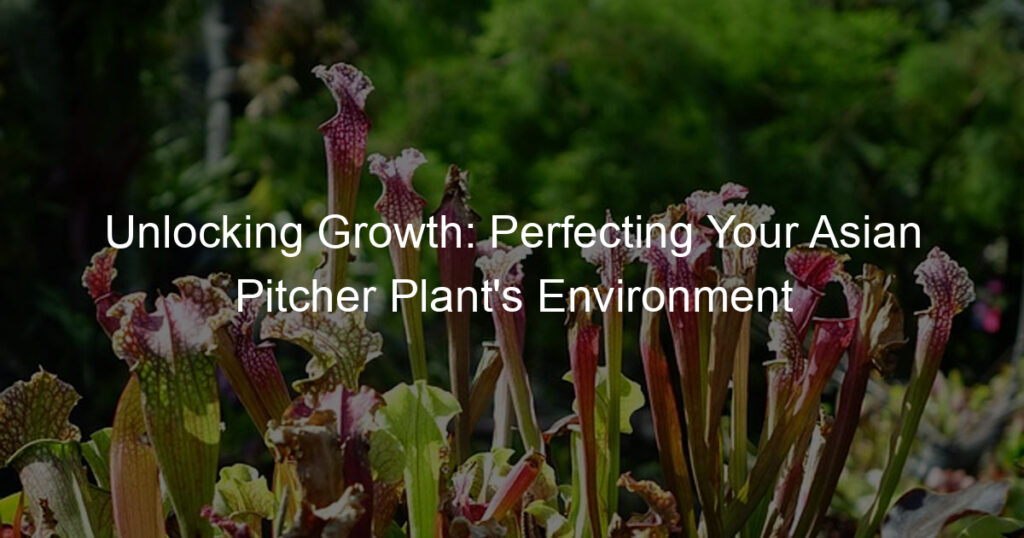
Introduction to Asian Pitcher Plants
Asian Pitcher Plants, scientifically known as Nepenthes, are a fascinating group of carnivorous plants native to the tropical regions of Asia. These unique plants have developed a remarkable adaptation to thrive in nutrient-poor soils by catching and digesting insects. Let’s delve into an overview of these intriguing plants and the importance of their optimal environment.
- Overview of Asian Pitcher Plants
- Importance of optimal environment for Asian Pitcher Plants
The Asian Pitcher Plant, or Nepenthes, is a species of carnivorous plant that is well-known for its large, pitcher-shaped leaves. These leaves act as traps for unsuspecting insects, luring them in with sweet nectar. Once inside, the insect finds it nearly impossible to escape, and the plant slowly digests it to supplement its nutrient intake.
There are over 130 known species of Asian Pitcher Plants, each with its unique characteristics. Some are small and compact, while others can grow to be quite large. The color of the pitchers can vary widely as well, ranging from green to red to almost black. Despite their differences, all species share the same carnivorous habit and the same need for a specific type of environment to thrive.
Asian Pitcher Plants are native to the tropical regions of Asia, including Malaysia, Indonesia, and the Philippines. They thrive in humid, warm environments with plenty of rainfall. These conditions allow the plants to grow and produce their characteristic pitchers.
However, these plants are not just adapted to any tropical environment. They are often found in nutrient-poor soils, such as sandy or rocky areas. This is where their carnivorous habits come into play. By catching and digesting insects, these plants can obtain the nutrients they need to survive that are not available in the soil.
Understanding the optimal environment for Asian Pitcher Plants is crucial for their conservation. As their natural habitats are threatened by deforestation and climate change, it is more important than ever to understand and protect these unique ecosystems.
Understanding the Asian Pitcher Plants Habitat
Asian Pitcher Plants, also known as Nepenthes, are fascinating carnivorous plants with unique adaptations for survival. Let’s delve into understanding their natural habitat and how to replicate these conditions for successful cultivation.
Natural Habitat of Asian Pitcher Plants
- Climate conditions: Asian Pitcher Plants thrive in tropical climates, with high humidity and temperatures ranging from 70 to 95 degrees Fahrenheit.
- Soil requirements: They prefer well-draining, acidic soil, typically a mix of sphagnum moss and perlite.
- Choosing the right location: In the wild, they grow in both lowland and highland areas. However, they need a location with bright, indirect light when grown indoors.
- Setting up the right temperature and humidity: Maintaining a warm temperature and high humidity is crucial. A terrarium or greenhouse can help achieve these conditions.
- Preparing the soil: The soil should be moist but not waterlogged. Rinse the sphagnum moss and perlite before mixing to ensure they are clean.
- Choosing the right plant: Different species of Asian Pitcher Plants have different care requirements. Choose a species that suits your environment.
- Planting process: Plant the Asian Pitcher Plant in the prepared soil, ensuring the roots are well covered but the plant is not too deep.
- Watering schedule: Water the plant regularly to keep the soil moist. However, avoid overwatering as it can lead to root rot.
- Fertilizing needs: Asian Pitcher Plants generally do not require additional fertilizing as they get nutrients from the insects they trap.
- Pruning and repotting: Prune dead leaves and pitchers to encourage new growth. Repot the plant every 2-3 years or when it outgrows its pot.
- Identifying common diseases and pests: Watch out for signs of pests like aphids and diseases such as root rot and mold.
- Effective treatments: Treat pests with insecticidal soap and diseases with appropriate fungicides. Always isolate affected plants to prevent the spread of diseases.
- Signs of healthy growth: A healthy Asian Pitcher Plant will have vibrant green leaves and well-formed pitchers.
- Adjusting care as the plant grows: As the plant matures, it may require more light and larger pots. Always monitor the plant’s health and adjust care accordingly.
- Introduction to the case study: In our next section, we will look at a case study of successfully growing an Asian Pitcher Plant indoors.
- Key takeaways: Understanding the plant’s natural habitat and replicating these conditions is key to successful cultivation.
- Recap of the best environment for Asian Pitcher Plants: A warm, humid environment with well-draining, acidic soil and bright, indirect light is ideal.
- Final tips for successful cultivation: Regular monitoring, proper watering, and timely pruning and repotting can ensure your Asian Pitcher Plant thrives.
In conclusion, with a little effort and understanding, you can create the perfect habitat for your Asian Pitcher Plant and enjoy its unique beauty.








